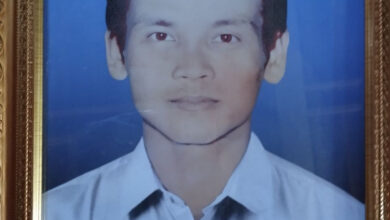
The Chin National Army (CNA), a Chin ethnic armed group operating in northwestern Myanmar, incapacitated a large military convoy on the road connecting Falam and Hakha in northern Chin State on Thursday, the group announced.
The convoy was made up of some 30 vehicles, two of which were armoured, and was near Chuncung village some 10 miles north of Hakha when the attack occurred. The anti-junta group used drones and land mines to inflict severe damage on most of the vehicles, including one tank, the group’s spokesperson Salai Htet Ni told Myanmar Now on Thursday afternoon.
“There were two tanks, and one of them was badly damaged. We can confirm that the vehicles were incapable of getting out of Chungcung. The fighting is still going on with reinforcements to Hakha cut off. Not a single vehicle was left in good condition,” Salai Htet Ni said.
Some civilian six-wheeled and twelve-wheeled trucks were among the vehicles, and Salai Htet Ni speculated that the military was using them to transport food and arms.
“We didn’t seize or salvage the vehicles, we just destroyed them. We can’t say for sure what was inside the trucks, but it likely would have been mostly ammunition, bombs, and military uniforms,” Salai Htet Ni said.
Later that day–the eve of Thingyan, the traditional Buddhist New Year festivities–the military launched four air raids in the area.
The raids occurred near Chungcung village at around 11:30am, Salai Htet Ni said. The extent of the damage and casualty count from these attacks is still unknown.
The CNA reportedly used drone strikes, ordinary landmines, and a kind of anti-tank mine that simultaneously detonates multiple charges arranged in rows.
According to Salai Htet Ni, the junta troops were defeated despite being better armed because of the Chin resistance forces’ knowledge of the area and effective guerrilla tactics.
The CNA and allied forces use their familiarity with the terrain to their advantage, and are skilled in finding weaknesses in junta convoys’ defences in order to launch successful surprise attacks, he said.
Local anti-junta forces frequently attack vehicles carrying supplies and reinforcements to military battalions operating in Chin State, and the recent attack on the convoy was the most damaging yet, he added.
The convoy that came under attack on Thursday had initially departed from Kalay Township, Sagaing Region, on March 7. It normally takes around 90 minutes to complete the 60-mile drive from Kalay to Falam, Chin State, but it had taken the junta convoy 12 days due to attacks along the road.
Because of similar delays, the convoy still had not reached Hakha, less than 50 miles from Falam, three weeks later. Chuncung, the village where the attack occurred, is located about 10 miles north of Hakha on the road from Falam.
Junta leader Min Aung Hlaing announced on March 27 that the military planned to take decisive action against ethnic armed groups abetting the anti-junta People’s Defence Forces and the publicly mandated National Unity Government.
Various junta attacks have occurred in Chin State since the announcement, including aerial strikes and the burning of villages by ground forces.
Just three days after the announcement, an unprovoked airstrike on the village of Khuafo, Thantlang Township, killed nine civilians, including children under 10 years old. There had been no previous fighting in Khuafo. In a similar incident on Monday, an air raid near a high school in Webula, Falam Township, killed a school principal connected to the Civil Disobedience Movement opposing the junta, along with eight other civilians.



